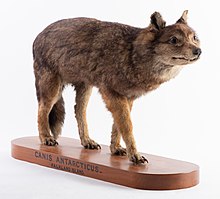| Falkland Islands wolf[1] | |
|---|---|

| |
| Mounted specimen in the collection of Otago Museum | |
| Scientific classification | |
| Domain: | Eukaryota |
| Kingdom: | Animalia |
| Phylum: | Chordata |
| Class: | Mammalia |
| Order: | Carnivora |
| Family: | Canidae |
| Genus: | †Dusicyon |
| Species: | †D. australis
|
| Binomial name | |
| †Dusicyon australis (Kerr, 1792)
| |

| |
| Location of the Falkland Islands | |
The Falkland Islands wolf (Dusicyon australis), also known as the warrah (/ˈwɑːrə/ WAH-rə or /ˈwɑːrɑː/ WAH-rah) and occasionally as the Falkland Islands dog, Falkland Islands fox, warrah fox, or Antarctic wolf, was the only native land mammal of the Falkland Islands.[3] This endemic canid became extinct in 1876, the first known canid to have become extinct in historical times.
Traditionally, it had been supposed that the most closely related genus was Lycalopex, including the culpeo, which has been introduced to the Falkland Islands in modern times. A 2009 cladistic analysis of DNA identified the Falkland Islands wolf's closest living relative as the maned wolf (Chrysocyon brachyurus), an unusually long-legged, fox-like South American canid, from which it separated about 6.7 million years ago.[4] However, the Falkland Islands wolf diverged from its mainland ancestor Dusicyon avus very recently, around 16,000 years ago.[5] Dusicyon avus persisted on the South American mainland until around 400 years ago.[6]
The Falkland Islands wolf existed on both West and East Falkland, but Charles Darwin was uncertain if they were differentiated varieties or subspecies.[7] Its fur had a tawny colour and the tip of the tail was white. Its diet is unknown, but due to the absence of native rodents on the Falklands, probably consisted of ground-nesting birds, such as geese and penguins, seal pups and insects, as well as seashore scavenging.[8] It has sometimes been said that it may have lived in burrows.[9]
- ^ Wozencraft, W. C. (2005). "Order Carnivora". In Wilson, D. E.; Reeder, D. M. (eds.). Mammal Species of the World: A Taxonomic and Geographic Reference (3rd ed.). Johns Hopkins University Press. pp. 532–628. ISBN 978-0-8018-8221-0. OCLC 62265494.
- ^ Sillero-Zubiri, C. (2015). "Dusicyon australis". IUCN Red List of Threatened Species. 2015: e.T6923A82310440. doi:10.2305/IUCN.UK.2015-4.RLTS.T6923A82310440.en. Retrieved 12 November 2021.
- ^ Portela, Roberto. "Evolutionary ecomorphology of the Falkland Islands wolf Dusicyon australis" (PDF). Retrieved 31 October 2020.
- ^ "New Clues To Extinct Falklands Wolf Mystery". EurekAlert. Science Daily. 2009-11-03. Retrieved 2011-09-03.
- ^ Austin, Jeremy J.; Soubrier, Julien; Prevosti, Francisco J.; Prates, Luciano; Trejo, Valentina; Mena, Francisco; Cooper, Alan (June 2013). "The origins of the enigmatic Falkland Islands wolf". Nature Communications. 4 (1): 1552. Bibcode:2013NatCo...4.1552A. doi:10.1038/ncomms2570. hdl:2440/74885. ISSN 2041-1723. PMID 23462995.
- ^ Prevosti, Francisco J.; Ramírez, Mariano A.; Schiaffini, Mauro; Martin, Fabiana; Udrizar Sauthier, Daniel E.; Carrera, Marcelo; Sillero-Zubiri, Claudio; Pardiñas, Ulyses F. J. (November 2015). "Extinctions in near time: new radiocarbon dates point to a very recent disappearance of the South American fox Dusicyon avus (Carnivora: Canidae)". Biological Journal of the Linnean Society. 116 (3): 704–720. doi:10.1111/bij.12625. hdl:11336/46106.
- ^ Darwin, Charles (1839). Narrative of the surveying voyages of His Majesty's Ships Adventure and Beagle between the years 1826 and 1836, describing their examination of the southern shores of South America, and the Beagle's circumnavigation of the globe. Journal and remarks. 1832–1836. (The Voyage of the Beagle). Vol. III. London: Henry Colburn. pp. 149–150.
- ^ Glover Morrill Allen (June 1942). Extinct and vanishing mammals of the Western Hemisphere: with the marine species of all the oceans. Cooper Square Publishers. ISBN 978-0-8154-0433-0. Retrieved 4 September 2011.
- ^ Massam, Steve. "The Evans Warrah, The Identification". Falkland Islands Museum and National Trust. Archived from the original on 2011-10-04. Retrieved 2011-09-04.
